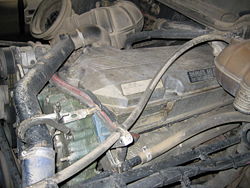
Detroit Diesel 60
Encyclopedia

Diesel engine
A diesel engine is an internal combustion engine that uses the heat of compression to initiate ignition to burn the fuel, which is injected into the combustion chamber...
that was first produced in 1987. It departed from most on highway engines, by being an overhead camshaft engine and having full "drive by wire" electronic control. In 1993 it became popular on many Charter buses in the US at 11.1 l (677 cu in). In 1993, the 11.1L version was rated at 350 bhp (but would produce 15 more if the cruise control was engaged). It was also available in 12.7 l (774 cu in) at the time. Both engine sizes were also used in truck and tractor trailer applications. In 1998 the 11.1-liter Detroit Diesel Series 60 was discontinued. Once the 11.1-liter Series 60 was discontinued, the 12.7-liter Detroit Diesel Series 60 became the motorcoach application. Starting in the late 1990s Neoplan made the Series 60 as an available engine for their high floor and low floor Articulated bus
Articulated bus
An articulated bus is an articulated vehicle used in public transportation. It is usually a single-deck design, and comprises two rigid sections linked by a pivoting joint...
es - the AN460A and AN460LF.
The most popular on highway Detroit Diesel engine was the 12.7-liter, and the on highway engines were electronically controlled by the propriety Detroit Diesel Electronic Control (DDEC) system. The DDEC system was the first commercial use of a fully electronically controlled on highway engine, and it would be a number of years before any other manufacturer would follow suit. The functions available in the DDEC system included engine diagnostic functions, shut down timers, progressive shift functions, fault history record keeping, speed limiting, automatic stall preventing, and cruise control functions, the cruise control function was particularly popular with fleet operators due to the fuel saving nature of this function, but most notably the DDEC system permitted the owner to be able to download periodical engine management reports, that would record the use of the engine, and be able to provide records of truck overspeeding, excessive idle time, hard braking and other parameters, that would assist owners to increase productivity and reduce engine abuse and decrease fuel consumption.
Larger fleets purchased their own version of the software, whilst smaller owner operators were able to have their computers downloaded by the dealer that serviced their engine. The DDEC system allowed dealers and owners to trouble shoot problems with their engines, and also permitted changes to horsepower settings, and in some cases, alternative programs were able to be loaded into the computer.
The DDEC system was particularly easy to operate, and diagnostic functions were able to be displayed to the driver. Typically there are two indicator lights, one in Yellow and one in Red. The Red indicator represents a significant engine fault, and in most cases the engine would automatically shut down to protect the engine from damage. The yellow light represented a minor fault, and was more of a cautionary function to alert the operator to a fault that might not be dangerous, or represent immediate damage to the engine. The operator is able to gain basic diagnostic functions via these two lights also. Accompanying the two lights there generally is a switch, when pressed in specific circumstances, the Red and Yellow lights will flash in a specific order and the operator is able to calculate a fault code, and know the specific problem with the engine.
DDEC I

DDEC II
The DDEC II Engine was available in ratings up to 425 hp and 1450 foot-pounds (1,965.9 N·m) of torque. The engine proved extremely popular with fleet operators, and built a strong reputation for reliability and longevity. It was also available in a popular "cruise power" configuration, which encouraged the operator to engage the cruise control function. During the normal use of the engine, 405 hp would be available, and when the cruise control was engaged the horsepower rating would increase to 425 hp, as the engine was the most economical whilst the cruise control was engaged.DDEC III
In 1992 the DDEC III system was introduced and was available in horsepower ratings up to 470 hp, and this was due to revised camshaft timing, and other improvements. Again, a "cruise power" option was available, and the standard rating was 430 hp, and when the cruise control was engaged the horsepower rating was increased to 470 hp. Again, encouraging operators to take advantage of reduced fuel consumption.DDEC IV
1997 Brought the introduction of the DDEC IV engine, and further improvements in the design of the engine, notably a wastegate turbocharger and engine management improvements provided increased horsepower ratings up to 500 hp, and increased torque outputs to 1650 foot-pounds (2,237.1 N·m).Series 60 14-liter
In 2001 a larger stroke crankshaft increased the engine volume to 14 l (854 cu in), the power increased to 575 hp and torque increased to 1850 foot-pounds (2,508.3 N·m).In 2007 the 12.7-liter Detroit Diesel Series 60 was discontinued. Once the 12.7-liter Series 60 was discontinued, the 14-liter Series 60 replaced it.

